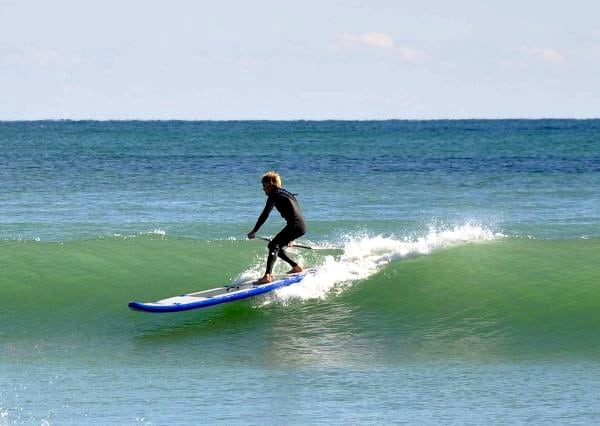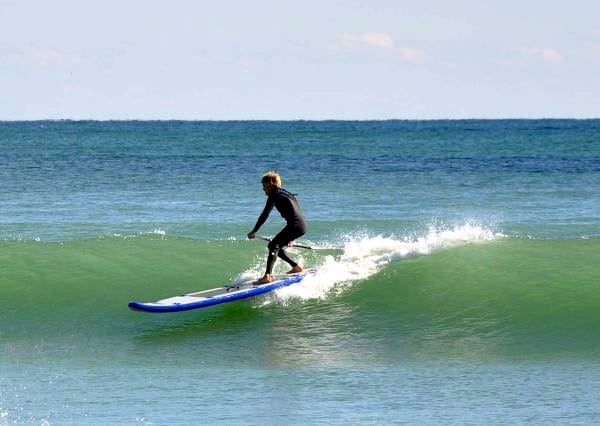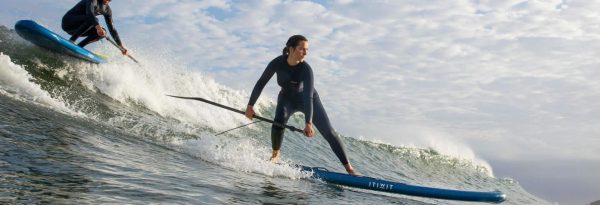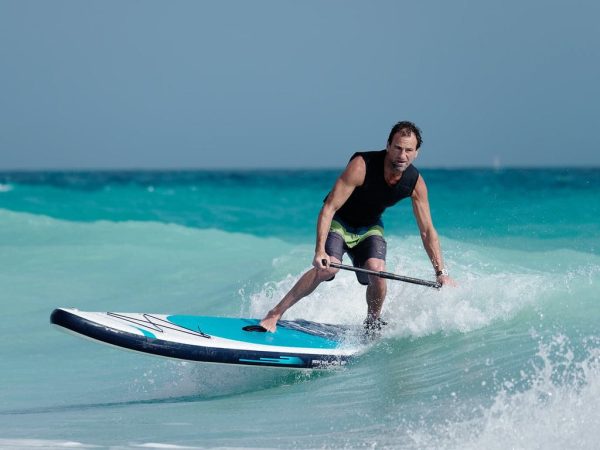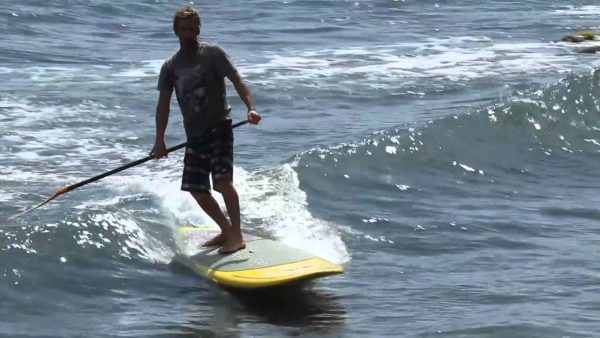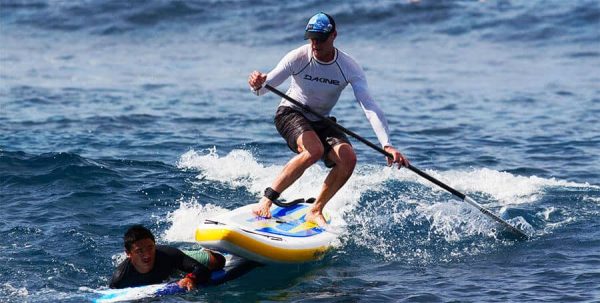We’ve all seen those folks paddling effortlessly on their stand-up paddleboards (SUPs) along the shoreline.
But have you ever wondered if you can use a SUP board for surfing? Well, wonder no more! In this article, we’ll explore whether your trusty SUP can handle the waves and give you the thrilling experience of catching that perfect ride.
So, grab your board shorts and get ready to paddle out as we delve into the exciting world of SUP surfing.
Types of Surfboards
Shortboards
Shortboards are the most common type of surfboard used by experienced surfers. They are typically less than seven feet long and designed for quick, high-performance surfing.
Shortboards have a narrow, pointed nose and a sharp, thin tail, which allows them to maneuver easily in the water. They are preferred for surfers who want to perform tricks and ride steep, powerful waves.
Longboards
As the name suggests, longboards are longer and more stable than shortboards. They are typically over nine feet long and have a rounded nose and a broad, flat tail. Longboards are ideal for beginners and surfers who enjoy a more relaxed riding style.
They provide better stability and glide, making catching waves and maintaining balance easier. Longboards are also suitable for small, mellow waves, allowing for easy paddling and smooth turns.
Fish Boards
Fish boards are a hybrid between shortboards and longboards. They are shorter and more comprehensive than traditional shortboards, with a slightly wider nose and a swallowtail.
Fish boards are known for their speed and maneuverability in smaller, mushy waves. They are famous for surfers who want to have fun in small to medium-sized waves, as they provide a lively and responsive ride.
Funboards
Funboards, also known as mini malibus, are a versatile option that combines the stability of a longboard with the maneuverability of a shortboard. They typically range in length from seven to eight feet and have a rounded nose and a wider tail.
Funboards suit surfers of all skill levels and can handle various wave conditions. They provide a good compromise between stability and performance, making them an excellent choice for progressing surfers who want to improve their skills.
What is a SUP Board?
Definition
A SUP (Stand Up Paddle) board, also known as a paddleboard, is a sizeable surfboard-like craft propelled by standing on it and using a paddle.
Unlike traditional surfboards, SUP boards are more comprehensive, longer, and stable, allowing riders to stand upright and paddle through calm water or ride waves. SUP boards originated in Hawaii and have gained popularity worldwide due to their versatility and accessibility.
Characteristics
SUP boards come in various shapes and sizes but generally have a comprehensive and stable platform. They range from nine to twelve feet and can be as comprehensive as 34 inches.
The boards are made from durable materials like fiberglass, epoxy, or inflatable PVC, which ensure their strength and buoyancy. Most SUP boards have a cushioned deck pad for comfort and grip and a fin setup for stability and maneuverability.
Uses
SUP boards have a wide range of uses beyond surfing. They can be used for recreational paddling on calm lakes and rivers, fitness workouts, yoga sessions, and even fishing—their stability and ease of use suit all ages and skill levels.
In recent years, SUP surfing has become a challenging and exciting way to ride waves. SUP boards allow surfers to catch waves earlier and paddle longer distances, expanding the possibilities of wave riding.
This image is the property of isupworld.com.
Advantages of Using a SUP Board for Surfing
Versatility
One of the significant advantages of using a SUP board for surfing is its versatility. SUP boards can be ridden in various wave conditions, from small, mellow waves to giant, more powerful ones. Their stability and buoyancy make them suitable for beginners learning to surf and experienced surfers who want to challenge themselves in different wave conditions.
Stability
SUP boards offer a higher level of stability compared to traditional surfboards. Their more comprehensive and extended design provides a more stable platform, making it easier for surfers to stand up and balance. This increased stability is especially beneficial for beginners still developing their balance skills. It enables them to spend more time on their feet and build confidence in the water.
Paddling Power
One of the unique advantages of using a SUP board for surfing is the paddling power it provides. With a paddle in hand, surfers can paddle faster and more efficiently than traditional surfboards, allowing them to catch waves earlier and with less effort. The ability to generate more paddling power gives SUP surfers an advantage in wave selection and getting into position for catching waves.
Wave Catching Ability
The longer length and increased buoyancy of SUP boards make it easier to catch waves. Surfers can start paddling well before the wave reaches them, allowing them to catch waves much earlier than with a traditional surfboard. This early wave entry increases the number of waves a surfer can catch during a session and makes it possible to catch waves that might be too small or slow for traditional surfboards.
Disadvantages of Using a SUP Board for Surfing
Difficulty Maneuvering
One of the main disadvantages of using a SUP board for surfing is the difficulty in maneuvering. The larger size and volume of SUP boards make them less responsive and harder to turn than shortboards or fish boards. This can limit the range of maneuvers that surfers can perform and require more effort and skill to execute tight turns or advanced tricks.
Limited Surfing Techniques
While SUP boards excel in catching waves and providing stability, they have limitations regarding specific surfing techniques. The larger size and paddle propulsion make performing aerial maneuvers or sharp cutbacks typically associated with traditional shortboards challenging. SUP surfing often focuses on longer, gliding rides and flowing turns that utilize the board’s stability and paddle power.
Crowded Waves
The increased popularity of SUP surfing has led to concerns about overcrowding in the lineup. SUP boards take up more water space and can pose a safety hazard to other surfers. SUP surfers must be mindful of their surroundings, respect the right of way, and maintain proper etiquette while sharing the waves with other surfers. Communication and awareness are crucial to ensuring a safe and enjoyable experience for everyone in the water.
This image is property of contents.mediadecathlon.com.
Choosing a SUP Board for Surfing
Board Length
When choosing a SUP board for surfing, the length of the board is an important consideration. Longer boards provide more stability and buoyancy, making them suitable for beginners or those seeking a more relaxed surfing experience. Shorter boards offer better maneuverability and responsiveness, allowing experienced surfers to perform more advanced tricks. Balancing stability and maneuverability based on individual skill levels and wave conditions is essential.
Volume
The volume of a SUP board determines its buoyancy and weight capacity. Higher-volume boards are more buoyant and can support heavier riders or provide extra stability for beginners. Lower-volume boards are more responsive and offer better control for experienced surfers. Choosing a board with the right volume ensures a comfortable and enjoyable surfing experience.
Shape
The shape of a SUP board plays a significant role in its performance. Wide and flat-nosed boards are more stable and provide better stability for beginners or those interested in flatwater paddling. Narrower, pointed-nose boards are better suited for advanced riders who prefer maneuverability and performance in the waves. The shape of the tail also affects the board’s performance, with rounded tails providing smoother turns and square tails offering better stability.
Fins
The fin setup of a SUP board affects its maneuverability and tracking. Single-fin setups offer better stability and tracking, making them suitable for cruising and flatwater paddling. Thruster setups, with three fins, provide more maneuverability and are commonly used for surfing. Some SUP boards also feature removable fins, allowing customization based on individual preferences and wave conditions.
Techniques for Using a SUP Board for Surfing
Paddling Technique
The paddling technique is crucial when using a SUP board for surfing. Using the paddle efficiently and effectively generates power and maintains balance. The correct paddle grip, body positioning, and stroke technique can significantly improve paddling speed and efficiency. Practicing proper paddling techniques will also help conserve energy and allow surfers to spend more time catching waves.
Getting Through Waves
Getting through waves is a fundamental skill for SUP surfing. Unlike traditional surfboards, which are duck-dived or turtle-rolled, SUP boards are typically paddled through oncoming waves. Timing is crucial, and developing the right combination of paddle power and timing to punch through the waves without getting swept back or losing balance is essential. Reading wave patterns and anticipating the impact zones can significantly assist in successfully getting through waves.
Taking Off
When taking off on a wave with a SUP board, it is essential to position oneself correctly and time the paddle strokes correctly.
Surfing etiquette dictates that the surfer closest to the breaking part of the wave has the right of way, so respecting this and avoiding interfering with other surfers is crucial. Paddling diagonally or parallel to the wave’s direction can help position and facilitate a smooth take-off.
Maneuvering
While SUP boards may not be as agile as traditional surfboards, maneuvers can still be performed. Basic turns, such as carving and trimming, are essential for maintaining speed and control on a wave.
Footwork and weight distribution play a crucial role in executing these maneuvers effectively. Practicing and refining these skills will allow surfers to maximize their SUP boards’ performance and explore different wave-riding styles.
This image is the property of cdn.shopify.com.
Tips for Using a SUP Board for Surfing
Start with Small Waves
When starting with SUP surfing, it is recommended to begin in small, mellow waves. Smaller waves provide a more forgiving environment for learning and allow surfers to focus on building foundational skills. Starting with small waves also helps develop wave judgment and timing and builds confidence in catching and riding waves.
Choose the Right Surf Break
Selecting the proper surf break is crucial for a positive SUP surfing experience. Considering the wave conditions, crowd factors, and local regulations is essential. Beginners should look for breaks that offer smaller, slower waves with minimal crowds. Surf breaks with long, mellow rides are ideal for SUP surfing, as they allow longer rides and more opportunities to practice turns and maneuvers.
Practice Balancing
Balancing on a SUP board is essential for maintaining stability and control. Practicing balance exercises on water, such as standing on one leg or performing yoga poses, can significantly improve balance and stability on the board. Regular practice will help develop core strength and stability, allowing surfers to stay upright and maintain control in challenging wave conditions.
Learn Surf Etiquette
Understanding and practicing surf etiquette is crucial when using a SUP board for surfing. Respecting the right of way, avoiding snaking or dropping in on other surfers, and communicating effectively are essential for maintaining a harmonious lineup. Awareness of others in the water, giving space, and following local rules and regulations contribute to a positive and safe surfing experience for everyone.
Safety Considerations for SUP Surfing
Wearing a Leash
Attaching a leash to your ankle or calf is essential for SUP surfing safety. A leash keeps the board attached to the surfer in case of a fall, preventing it from becoming a hazard to others or getting carried away by the waves. Choosing a leash appropriate for the SUP board size and wave conditions is essential to ensure optimal safety.
Protective Gear
While not mandatory, wearing protective gear like a helmet and rash guard can provide an added layer of safety during SUP surfing. A helmet can help protect against head injuries, especially in crowded lineups or when attempting more advanced maneuvers. A rash guard protects against sunburn and chafing, keeping the skin safe and comfortable during long sessions in the water.
Awareness of Other Surfers
Being aware of other surfers in the water is essential when SUP surfing. The size and visibility of a SUP board can potentially create blind spots, obstructing the view of other surfers.
It is crucial to maintain constant awareness of one’s surroundings, communicate effectively, and give ample space to other surfers. Respecting and considerate of other surfers will help prevent accidents and ensure a safe and enjoyable surfing experience.
Handling Wipeouts
Wipeouts are inevitable in surfing, and it is essential to know how to handle them safely. When falling off a SUP board, it is crucial to fall away from the board to avoid getting hit or tangled in it.
Holding on to the paddle is not recommended during a wipeout, as it can cause injury or entanglement. Surfers should also be mindful of their surroundings and ensure they surface safely after a wipeout to avoid collision with other surfers or their boards.
This image is the property of i.ytimg.com.
SUP Surfing vs. Traditional Surfing
Paddling Technique
The primary difference between SUP surfing and traditional surfing is the paddling technique. In SUP surfing, the paddler stands upright and uses a paddle to propel themselves through the water. Traditional surfing involves lying or kneeling on a surfboard and using the arms to paddle. SUP surfing offers the advantage of increased paddling power and efficiency with a paddle, allowing surfers to cover longer distances and catch waves earlier.
Wave Selection
The ability to catch waves earlier and generate more paddling power gives SUP surfers an advantage in wave selection. They can catch waves further out in the lineup and take advantage of smaller, slower waves that may be inaccessible to traditional surfers. Traditional surfers rely on wave propulsion and positioning to catch waves, while SUP surfers have the added advantage of paddling onto waves before they break.
Maneuverability
In terms of maneuverability, traditional surfboards have the upper hand. Shortboards, fish boards, and other traditional surfboard shapes are designed for maximum maneuverability and responsiveness. SUP boards, on the other hand, are larger and less maneuverable due to their shape and added buoyancy. W
While SUP boards can still perform basic turns and maneuvers, they are not as agile as traditional surfboards, limiting the range of maneuvers that can be executed.
Physical Demands
SUP surfing requires a different set of physical demands compared to traditional surfing. The use of a paddle and the larger size of the board emphasize upper-body strength and endurance.
Paddling and maintaining balance on a SUP board engage the core muscles and improve overall stability. Traditional surfing, on the other hand, relies more on lower body strength and balance when riding the wave. Both disciplines offer excellent full-body workouts but focus on different muscle groups.
Conclusion
Using a SUP board for surfing opens up new possibilities and experiences in wave riding. SUP boards offer versatility, stability, and increased wave-catching ability that surfers of all skill levels can enjoy.
While disadvantages include difficulty maneuvering and limited surfing techniques, the benefits of using a SUP board for surfing outweigh the challenges for many enthusiasts.
By selecting the right SUP board, practicing proper techniques, and adhering to surf etiquette and safety considerations, surfers can enhance their experience and enjoy the unique thrill of SUP surfing.
Whether cruising along calm waters or catching waves, SUP surfing offers a refreshing and exciting way to connect with the ocean and explore the art of wave riding.
This image is the property of learntosurfkona.com.
Roc Inflatable Stand Up Paddle Boards with Kayak Seat and Premium SUP Paddle Board Accessories, Wide Stable Design, Non-Slip Comfort Deck for Youth & Adults (Navy)
FBSPORT Premium Inflatable Stand Up Paddle Board, Yoga Board with Durable SUP Accessories & Carry Bag | Wide Stance, Surf Control, Non-Slip Deck, Leash, Paddle and Pump for Youth & Adult
Aqua Plus 6inches Thick Inflatable SUP for All Skill Levels Stand Up Paddle Board,Paddle,Double Action Pump,ISUP Travel Backpack, Leash,Shoulder Strap,Youth,Adult Inflatable Paddle Board
Bifanuo 10.5'x30''x6'' Inflatable Stand Up Paddle Board with SUP Accessories & Backpack. Non-Slip Deck,Wide Stance,Bottom Fin,Double Action Pump.Youth & Adult Standing Boat(Pink Yellow)
SereneLife Inflatable Stand Up Paddle Board (6 Inches Thick) with Premium Accessories & CarryBag | Wide Stance, Bottom Fin for Paddling, Surf Control, Non-Slip Deck
5 used from $218.94

